There are dozens of specialty diving certifications you can obtain depending on your level of experience and expectations. Whether you’re looking to move on to more advanced types of diving or you’re just curious to see what other options there are, we’ve got you covered.
Diving can be divided into two large categories: scuba diving and freediving. While freediving is done at breath-hold, scuba diving requires a breathing apparatus. There are many different types of scuba diving, each defined as either recreational or professional. Let’s go over each of the common types of diving and their main characteristics.
Scuba Diving
Recreational Diving
Training: Recreational diver training is done by instructors who are themselves certified to conduct diving courses for specific levels of expertise. Some of the most known and recognized training agencies are PADI, SSI, NAUI, CMAS, and TDISDI. Certifications issued by internationally-renowned organizations will be recognized by diving operators anywhere in the world.
Drift Diving
Drifting is one of the most rewarding types of diving, but one that requires knowledge and precaution. As opposed to other forms of diving, drift diving implies going where the current takes you rather than planning where you go. The force that moves divers may be an ocean current, tidal current, or the natural course of a river, depending on where you’re diving.
Drift diving is relaxing and it’s also the quickest way to get to your next point of interest. However, the current may carry you to unpredictable places. As such, this form of diving requires a good sense of navigation, scuba diving experience and confidence. As you learn to go with the flow, it will almost be like you’re flying, as many divers describe the feeling of drifting.
While drift diving is generally safe as long as divers are properly trained and carry the right equipment, there are a few things to consider. Divers need a surface marker buoy (SMB) or a delayed surface marker buoy (DSMB) so that the skipper of the dive boat knows where they are. Being separated from other divers and taken away from the dive site to unknown waters are dangers to be aware of.
Popular Drift Diving Sites
- Blue Corner, Palau – A 30-meter (98 feet) dive with abundant marine life and strong currents that often require a reef hook.
- Washing Machine, Bahamas – The currents can roll divers head over heels, sweeping one down to 12 meters (40 feet) then lifting them back up at 5 meters (15 feet).
- Batu Bolong, Komodo – A macro lovers’ haven, filled with marine fauna of all sizes and well-preserved coral gardens. Some parts of the site may become inaccessible because of the strong current.
- Tumakohua Pass, Fakarava – Divers enter through a canyon from where the current takes over and transports them through the channel. Lively dive where one may spot schools of sharks numbering over 100 members.
Wreck Diving
There’s something terribly intriguing in exploring mysterious wrecks underwater. Some have been on the bottom of the ocean, sea or river for thousands of years. Many are among the last physical remnants of tragedies that happened throughout the course of history. Most of these wrecks are taken over by underwater flora and attract ecosystems of fish that bring life to these artificial constructions.
While not all wrecks offer something to be discovered, there are plenty of pirate ships and large vessels where one can still observe their mechanical parts and different items they were carrying before sinking. But not all wrecks are ships or boats. Airplanes, submarines, trains, buses, and naval radar stations are also among the popular types of wrecks divers can explore.
Wreck diving is generally safe, but it does come with a few risks. Venturing inside a wreck may result in an injury or getting stuck in parts of the wreck. These are unstable structures that break apart continuously. Divers also face the danger of getting tangled in rigging, fishing nets, or even their wreck reel. Even if one doesn’t go inside, there’s still the risk of suffering lacerations when swimming too close to it.
Popular Wreck Diving Sites
- SS President Coolidge, Vanuatu – One big, luxurious wreck! Nearly 200 meters (650 feet) long and 25 meters (16 feet) wide, resting at a depth of 70 meters (230 feet). Guns, cannons, trucks, helmets, and other items can be seen.
- USAT Liberty, Bali – The signature dive in the area. An accessible wreck dive smothered in marine growth. Divers can encounter spectacular marine species like mantis shrimps and sea anemones, among larger animals.
- Fujikawa Maru, Truk Lagoon – Pink and white soft corals adorn this beautiful ship where shoes, gas masks, beer bottles, and other items can be found. One of the best sites for wreck penetration.
- C-53, Cozumel – Also known as Felipe Xicotencatl, the minesweeper is popular for being an accessible wreck with large openings that allow for penetration. It’s a rather clean wreck, most likely because of the currents that circulate the area.
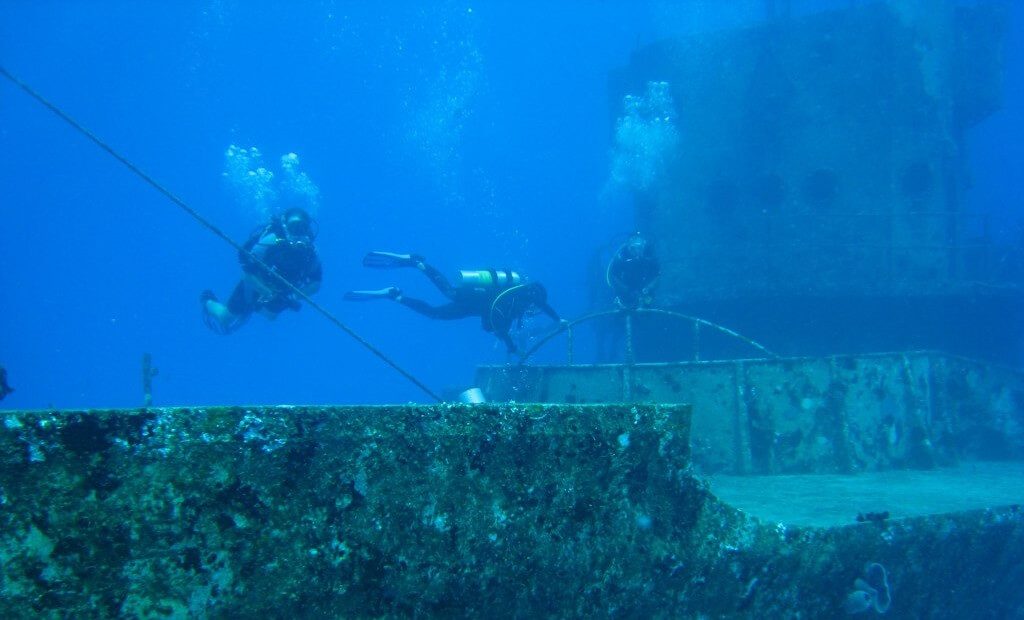
Divers exploring the C-53 wreck, Cozumel. Picture by tslane888
Deep Diving
What is considered a deep dive depends on the scuba diver training organization, but a deep diving certificate generally allows one to dive down to 40 meters (131 feet). Most divers want to obtain this certification so that they can dive wrecks, caverns, and caves. Or one may simply want to swim alongside marine creatures that inhabit deeper waters and see coral plateaus sitting at depths of around 40 meters.
Some risks are associated with this type of scuba diving, however. Decompression sickness is the main risk, and it occurs because the deeper you go, the quicker the nitrogen is dissolved into the tissues of the body. Decompression stops need to be carried out during ascent to allow the body to expel the inert gases from the body.
Popular Deep Diving Sites
- The Great Blue Hole, Belize – A UNESCO World Heritage Site, it’s the largest natural formation of its kind, measuring about 318 meters (1040 feet) across. It has a depth of 125 meters (410 feet).
- Elphinstone Reef, Marsa Alam – This long reef measures over 400 meters (1312 feet) in length and has a maximum depth of about 70 meters (230 feet).
- Tiputa Pass, Rangiroa – Rangiroa is one of the largest atolls in the world, and Tipua Pass is one of the top sites in the area, abounding in marine life. It has a maximum depth of about 46 meters (150 feet).
- Darwin’s Arch, Galapagos Islands – Among the most popular dives in the world, this is the place to go if you want to swim alongside large marine animals.
Cave and Cavern Diving
Cavern Diving
Cavern diving is done close to the entrance of a cave, where one is still able to see the natural light and can easily find the exit. Divers swimming these waters don’t usually go further than 40 meters (130 feet) from the surface and always keep the entrance of the cave in sight. Cavern diving is considered a form of recreational diving that requires a specialty diver certification from any open-water training agency.
Although less dangerous than cave diving, cavern diving is not without risk. Common things that may occur during a dive involve the misuse of a guideline to open water, not adhering to the rule of thirds, giving in to the lure of the deep and venturing too far without proper skills and equipment.
Cave Diving
Cave diving is a form of technical diving that requires several years of training, special certification, and a different set of equipment than that used for open-water and cavern diving. It’s done as an extreme sport, for research purposes, or for the recovery of lost divers.
As with penetration diving, in case of an emergency, the diver cannot swim vertically towards the surface; they must swim the entire way back out. Navigating complex cave systems can be difficult, with exit routes at considerable distances. Many consider cave diving one of the deadliest sports in the world, yet this is mostly because of poorly trained divers that venture into caves without the proper set of skills and equipment.
Being among the most dangerous types of scuba diving, there are several dangers associated with cave diving. These include encountering an overhead environment that prevents one from making an unplanned exit to the surface in case of emergency, increased air consumption due to stress, sediment that causes visibility to drop to near zero, and so many other risks.
Popular Cave and Cavern Diving Sites
- Orda Cave, Perm – The largest underwater gypsum cave in the world, with a length of 4,600 meters (15,092 feet). Incredibly clear water due to the gypsum rock that acts as a filter.
- Kilsby’s Sinkhole, Mount Gambier – A 65-meter (213-foot) limestone cavity filled with fresh water. Used for recreational diving and as a training site for police divers.
- The Pit Cenote, Tulum – The deepest cenote in Quintana Roo, measuring 119 meters (391 feet) in depth.
- Cenote Dream Gate, Tulum – Many say it’s the best cavern dive in the area. Requires excellent diving skills so as not to destroy the fragile rock formations.
Night Diving
Night diving is diving in little to no ambient light. It often occurs at night, but it may also occur at dusk. Furthermore, cave diving, diving in murky or extremely low visibility water, and diving under an overhang may also be referred to as night dives. Divers need to complete a specialty course to be allowed to go on night diving trips.
But why would one go on a night dive? Firstly, because it’s a totally different experience. There are many nocturnal animals that shy away from daylight and you may only observe them during the night. There are also bioluminescent creatures that emit their own light, and it’s pretty magical to see them. Night diving also ensures some amazing shots for underwater photographers.
Darkness creates some risks divers need to be aware of. Flashlight failure is the most obvious one; it leads to loss of visual references, inability to control depth or to read instruments and control buoyancy. Precautions such as bringing three lights – a powerful main light of about 1,100 lumens, a backup light, and a signal light – are in order. Bear in mind that shining light into other divers’ eyes can damage their night vision.
Popular Night Diving Sites
- Pearl Rock, Fiji – Perfect location for night diving for those interested in diving with sharks.
- Blue Lagoon, Bali – White-tip reef sharks, strange crabs, lobsters, and the Spanish dancers are among the creatures one can expect to see here during the night.
- USS Kittiwake, Grand Cayman – Lively marine life out hunting during the night by the moon-lit wreck.
- San Francisco Wall, Cozumel – A healthy, shallow reef featuring low current where an abundance of aquatic creatures come out of hiding at night.
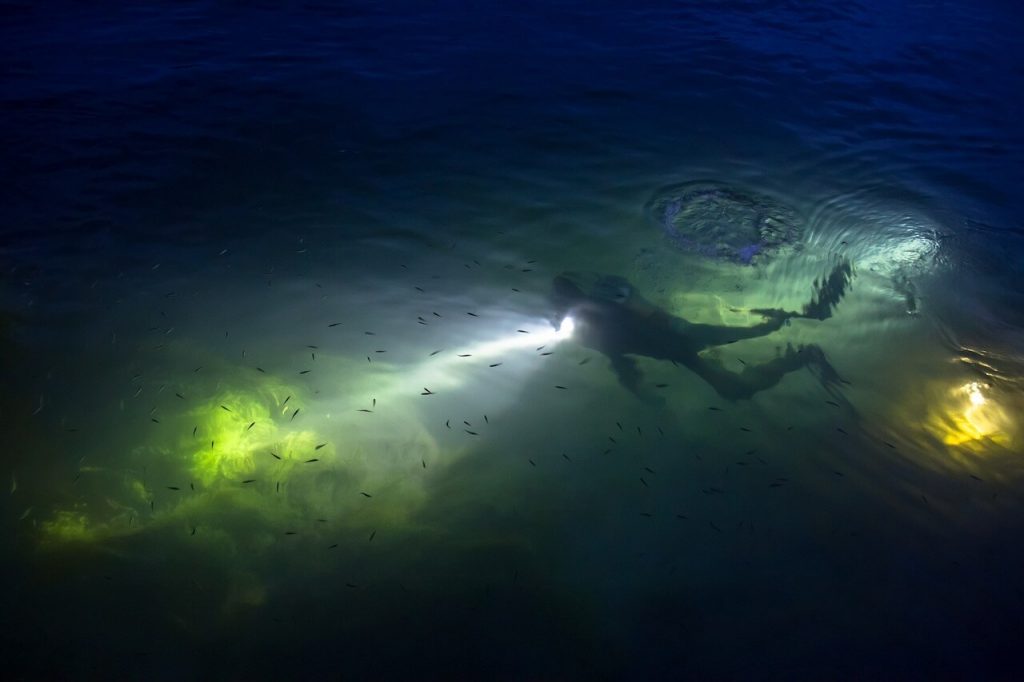
Diver exploring the reef at night.
Technical Diving
There’s some disagreement as to what technical diving is. However, there’s a general agreement that technical diving is a type of scuba diving that exceeds the limits of recreational and commercial diving for depth and bottom time, involves accelerated decompression, and makes use of variable gas mixtures.
Tech diving also means exposure to a (natural or artificial) ceiling that does not allow the diver to ascent to the surface vertically. Consequently, cave and wreck diving are considered by some to be forms of technical diving. A technical diver is also prevented from making a quick ascend to the surface due to decompression obligation.
Technical diving may expose the diver to dangers beyond those normally associated with recreational or commercial diving. Going deep for longer periods of time poses more risks for techs than other types of scuba diving. Some of the main ones involve decompression sickness, improper breathing technique, overexertion, and misuse of diving equipment.
Popular Technical Diving Sites
- San Francisco Maru, Micronesia – Sitting at a depth of 64 meters (210 feet), the shipwreck holds are filled with tanks, torpedoes, and mines.
- Drop Off, Verde Island – A haven for recreational and technical divers alike. The reefs and drop off goes all the way down to 75 meters (250 feet).
- Tower, Sharm El Sheikh – Spectacular dive site that features a 120 meter- (394 foot-) long canyon.
- Anemone City, Sharm El Sheikh – Features a beautiful big reef with walls descending to a depth of about 150 meters (492 feet).
Ice Diving
One of the most challenging types of scuba diving, ice diving is a penetration dive that takes place under ice. The dive time is limited to less than 30 minutes to reduce exposure to freezing temperatures. Ice divers usually dive one at a time while the other team members ensure the diver’s safety.
But why would anyone want to dive under ice? For starters, ice diving can provide unique encounters with animals such as penguins and seals or animals you may not be able to observe during summertime. Furthermore, those diving in freshwater will notice that clarity tends to increase in the winter due to lack of water circulation.
There are many risks associated with ice diving; hypothermia, getting lost under the ice, and regulator failure are among the main ones. Divers are always tethered for safety, meaning they must wear a harness clipped to a safety line that is secured above the surface.
Popular Ice Diving Sites
- Lake Baikal, Russia – The world’s oldest lake, home to an enormous number of endemic species.
- Rummu Quarry, Estonia – A former limestone mining site and prison turned into an adventure center where one can practice different outdoor sports.
- Sea Of Okhotsk, Shiretoko Peninsula – This dive site offers divers a chance to swim with sea angles (clione) and admire anemones and sea urchins.
- White Sea, Russia – Great visibility, amazing photographic opportunities, and abundant fauna. A good place to spot Beluga whales.
Altitude Diving
Altitude diving is defined as the type of diving that takes place in waters found at altitudes higher than 300 meters (1,000 feet) above sea level. While most divers only experience dives below sea level, there are plenty of high-altitude dive sites around the Globe that offer a select few unique underwater experiences.
High altitude poses some unique challenges divers may otherwise not experience when diving at sea level. Reduced atmospheric pressure and freshwater affect the depth gauges. Altitude divers are also more exposed to decompression sickness because the effect of diving at altitude is greater than it would be at sea level. Because of this, there are shorter no-decompression times.
Popular Altitude Diving Sites
- Lake Titicaca, Peru – Situated at 3,810 meters (12,500 feet), it is the highest elevation lake where recreational diving is allowed. The majority of the fish found here are endemic species.
- Yellowstone Lake, Wyoming, U.S.A. – With an elevation of 2,372 meters (7,783 feet) and fast-paced currents, it’s the perfect high-altitude adventure dive.
- Lake Atitlán, Guatemala – Located at 1,562 meters (5,026 feet), it’s a massive volcanic crater where divers can see volcanic hotspots and rock formations.
- Weissensee, Austria – Also an ice diving spot, the lake is famous for its crystal-clear waters and resident fish which grow to large sizes.
Professional Diving
Training: Professional divers are trained to dive safely as a member of a dive team and to gain the specific skills required for their employment. Training is usually done through registered diving schools and varies according to the legislative requirements of each country. Military diver training is usually done in the same armed force where the diver will be operating in, and it’s provided by a specialist training establishment.
Commercial Diving
Commercial diving covers a wide array of activities and tasks, and it’s not always limited to the offshore environment. These highly skilled professionals work in dangerous circumstances with difficult work schedules. Lots of training is required to succeed and stay safe in these careers.
Most often, this type of scuba diving is associated with the oil and gas industry. However, commercial divers also work on land-based civil engineering operations, in hazardous materials environments and nuclear power plants. Scientific divers and media divers (filmographers and photographers) are also among the common types of commercial divers.
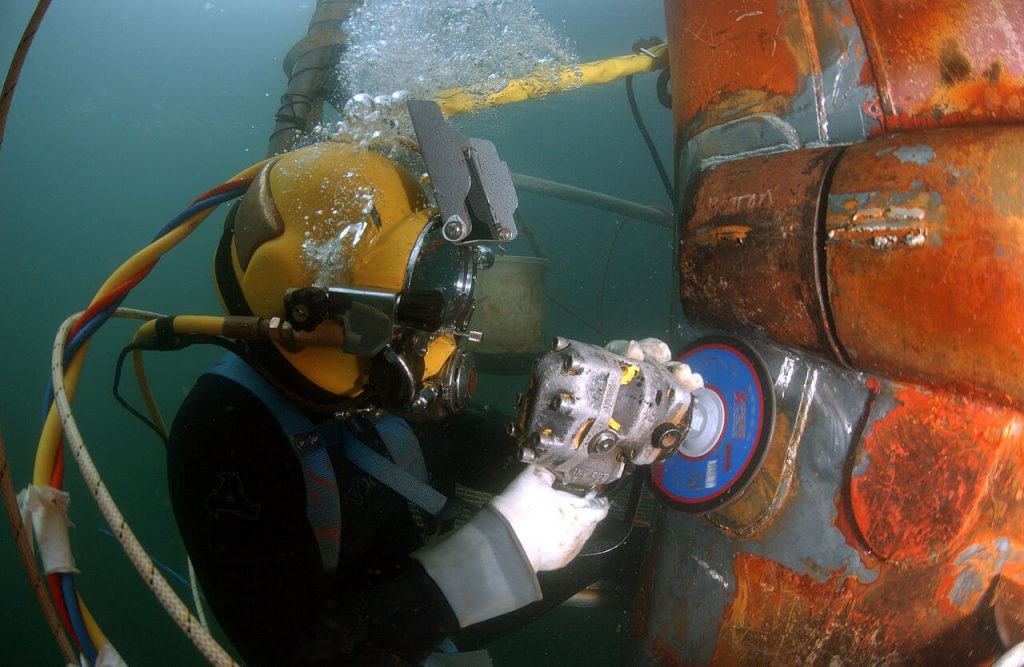
Diver repairing a landing platform. Picture by Andrew McKaskle
Rescue Diving
Rescue diving is a challenging and rewarding profession. These divers respond to emergency situations, most often when there are other divers underwater in need of help. These experienced professionals are trained in depth rescue, surface rescue, first aid techniques, and emergency management, among others.
Yet you don’t have to be a professional to earn a rescue diver certification. Anyone who wishes to learn how to manage problems in the water and become a better diving buddy can enroll in a specialized course at any of the diver training agencies offering this option.
Military Diving
Military divers work in various branches of the armed forces, including marines, army, air force, the navy, and coast guard. They’re essential to many missions, doing combat work, search and rescue, ship maintenance operations, underwater engineering, and bomb disposal, among others.
Freediving
Training: Freediving is not for everyone, but those that wish to pursue it either recreationally or competitively can take freediving/apnea courses provided by AIDA, Apnea Academy, PADI, NAUI, SSI, CMAS, FII, PFA, TDISDI, and other recognized diving organizations and agencies.
Humans first started freediving out of necessity, mostly for food and items which they could then sell, but also to recover items lost overboard. As time passed, it has evolved into a pastime activity and even a popular sport.
Freediving – or apnea diving – is diving while holding one’s breath, without the help of a breathing apparatus. Various techniques help freedivers stay underwater longer and go deeper with only one breath of air. Some define freediving as an advanced form of snorkeling, but it’s so much more than this.
But why would one freedive and expose themselves to risks that are minimized when using a breathing apparatus? Freediving offers an exhilarating experience; there’s no heavy equipment holding you down, you can twist and turn with ease, come closer to marine animals, and allows you to get to know yourself better both mentally and physically.
Freediving requires a lot of discipline and great swimming skills. It’s a dangerous activity that can result in fatalities. Drowning is a huge risk, and so is shallow-water blackout, which is the loss of consciousness due to lack of oxygen to the brain.
Competitive freediving, however, is a rather safe sport because all competitions are held under AIDA authority where strict safety rules are imposed.
Popular Freediving Sites
- MS Zenobia, Cyprus – The wreck of a massive ship that French freediver Guillaume Néry described as being so big it resembles an underwater building.
- Dean’s Blue Hole, Bahamas – Famous “playground” for professional freedivers. It’s the world deepest blue hole, bottoming out at 202 meters (662 feet).
- Christ of the Abyss, Italy – A submerged bronze statue honoring Dario Gonzatti, the first Italian to use scuba gear, who lost his life to scuba diving in 1947.
- Blue Hole, Sinai – This 56-meter (184 feet) dive site is reputed for having the largest number of fatalities in the world. A popular freediving training site, as the reef surrounding it protects it from currents and waves.
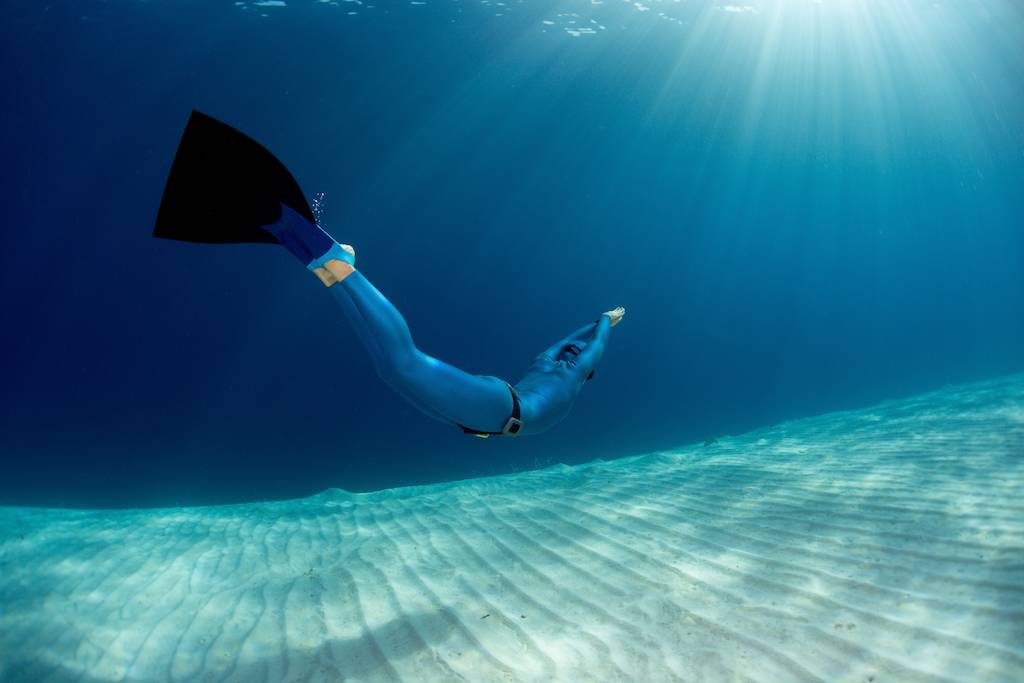
Freediver
Which of these popular types of diving have you tried so far and what are you ready to experiment with next? Leave a comment below and tell us about your diving experiences!
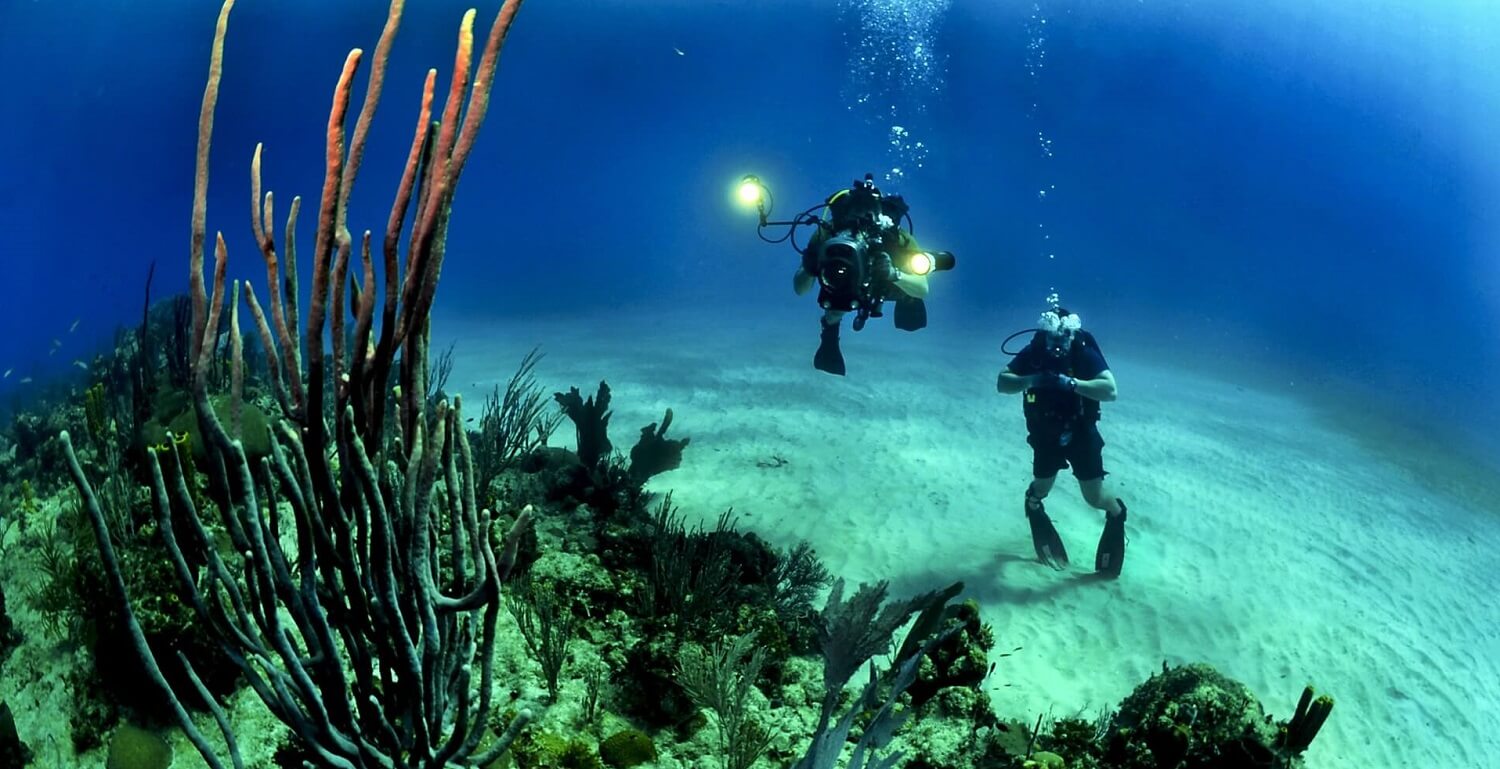
Tyler Johnson says:
I’m glad that you mentioned that you would need to have special training in order for you to go night diving. I think it would be super cool to dive a night where there is little to no light. I would think that would be a good way to see different animals underwater, so I might have to get trained to night dive so I could try it sometime.
John says:
I’ve recently passed my rescue diver course working in master diver next. I really enjoyed your article and thank you for the links to other dive sites.
Gregory Lange says:
Living on an island in the Pacific Northwest makes it possible for us to freedive all year around with ease. So much to see in these clear cold waters. Nothing beats suiting up ,diving for a hand grabbed dungeness crab dinner and back home cooking crab in an hour.
Robert Harris says:
I did a night dive as part of my AOW course. I had completed 4 open water training dives then the night dive. On the next day following certification as an Open Water Diver